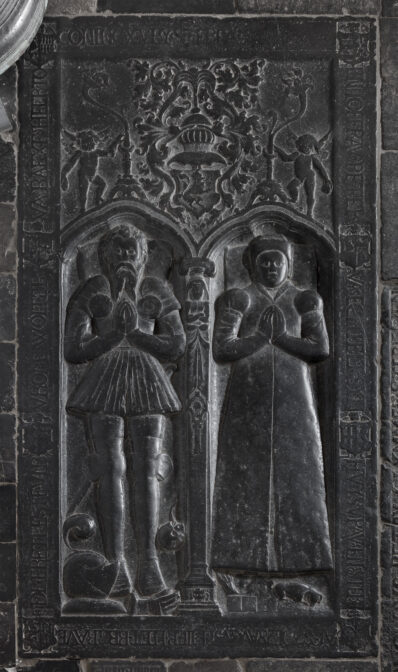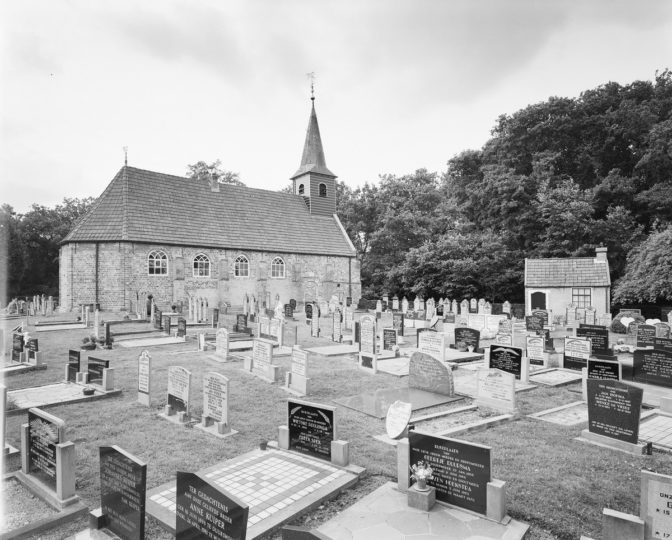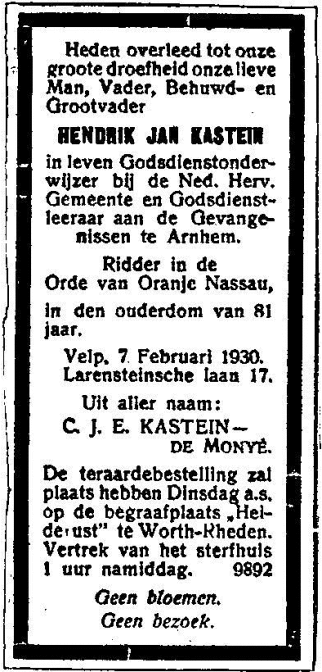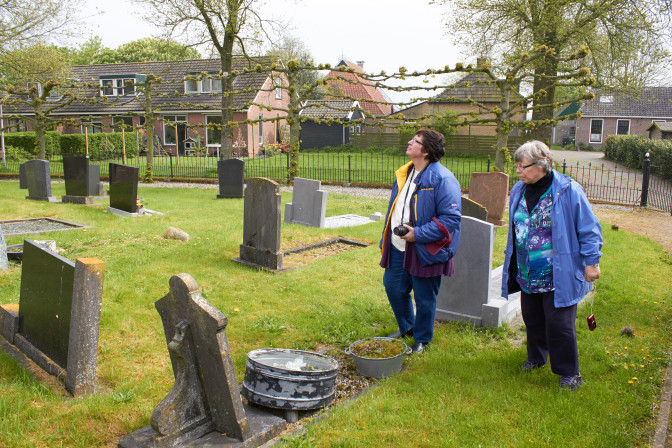So you know where your ancestor lived in the Netherlands, and you know where and when they died. How do you find out where they are buried, and if the grave still exists? Graves are routinely cleared in the Netherlands after a few decades, so even knowing where a person was buried is no guarantee that the grave is still there.
Burials in churches
Until 1828, it was legal to bury people in churches. This was more expensive, so usually only richer people were buried inside the church while poorer people were buried in the church yard around the church. Graves inside churches were often covered by a granite slab inscribed with the name of the deceased and other information. Graves outside the church did not always have markers, or had wooden markers that may not exist anymore.

Grave of Wolter van Baexen (d. 1559) and Peterke van Echtelt (1557), Zaltbommel. Credits: C. Booms, object 10702-7323, Cultural Heritage Service (CC-BY-SA)
Some of these lists of surviving graves in churches have been published, for example:
- P.C. Bloys van Treslong Prins, series of books about names found on markers and graves in churches, organized by provinces, published in the 1930s. The books are called Gedenkwaardigheden in en uit de kerken der Provincie [name of province]. Some are available online via Delpher.
- Hester de Walle, Friezen uit Vroeger Eeuwen. Collection of inscriptions on graves, items, signs, etc. from Friesland. Available as book and online database.
- F. P. Roobol-Lintelo and L. P. Roobol, “Graven in Groningen,” PDF, index of graves in Groningen 1814-1828, FamilyAffairs.
Burials in churchyards and cemeteries
Before 1829, most people were buried in the churchyards around the church. After 1829, new cemeteries had to be built outside the town limits. Some churchyards remained in use, but new cemeteries were built on the outskirts of town. Some religions had their own cemeteries, like the Jewish cemetery Zeeburg in Amsterdam.
Another change in 1829 was that graves could no longer be bought, only leased, typically for a period of ten to thirty years. After the lease expires, the cemetery had the option to reclaim the grave. Any remains are usually reburied in a communal grave. Sometimes, the grave markers or row makers remain the same, so if the burial record told you the grave or line number, you can figure out exactly where your ancestor was buried even if the grave no longer survives. Typically, however, the burial records do not list those details.
Though there are no guarantees that graves older than ten years survive, you might be lucky. Chances of graves surviving are higher in areas with a lower population density, where it was easier to expand the cemetery. Jewish cemeteries are never cleared, so if your ancestors were Jewish you are more likely be able to find their graves.

Churchyard at the Wijnjewoude Dutch Reformed Church. Credits: J.P. de Koning, collection Cultural Heritage Service (CC-BY-SA)
Burial records
Several types of burial records may have been created:
- The church custodian may have kept a list of burials
- The church administrators may have kept records of payments for burials, ringing of the church bells, rent of palls, or purchase of crypts.
- The tax collector may have kept a record of death duties.
Burial records before 1811 can typically be found in the series of church records which were turned over to the provincial archives. The records are often available online as index and/or scans via websites such as WieWasWie, Open Archives, Archieven.nl, or FamilySearch. If you find a burial record, that tells you where a person was buried, but not if the grave survives.
See also the Digital Resources Netherlands and Belgium. Go to the internet page for the province and search for “graven” [graves] or “begraaf” [burial].
After 1811, these records are not always turned over to archives. They may still reside with the church or municipality. I recommend contacting the regional or local archives to ask if they know where these records are kept.
Indexed graves
Several volunteers have indexed surviving graves, both in churches and in cemeteries. See the post about online cemeteries for a list of search engines of graves.
Family announcements
You may find that the family announced the burial service, for example:
- in an announcement in the newspaper
- in a letter to the family
- in a prayer card
These announcements may include the date and time of the funeral, including the cemetery or crematorium.

Hendrik Jan Kastein death announcement, which includes the details of his funeral.
Contacting the cemetery
If you know, or think you know, where your ancestor is buried, and you cannot find them in online indexes of cemeteries, you may have to contact the cemetery. Begraafplaats.nl has a list of all the surviving cemeteries in the Netherlands. Some cemeteries have a website that has a list of graves.
Visiting the grave
If you locate the cemetery or church where your ancestor was buried, you can visit. Most cemeteries are open to the public between sunrise and sundown. Churches may have more limited hours, so try to check the website of the church first. In smaller communities, if you find the gate or church locked, ask a local. Often there is a neighbor with a key who will let you in.

Roberta Estes and Cheryl Ferverda visiting graves at the Baard cemetery in Friesland. Photo by author.


I was shocked to find this. Those distant relatives of Swart (changed to Swartz in the US for some reason) and Korf in the US I found with trees on Ancestry I don’t think know about these links. I just found my paternal great great grandparents on my grandmother’s side plus their children’s records. Still need to search for burial place of Ritske Geerts Swart. Not sure if he went to the US. I will add my great great grandmother to FindAGrave and link her children. So much of my family especially my father’s side is a mystery. After spending 20-30 hours a week since Oct of last year I have learned more than I ever knew I could have.
Thank you for this website. I wish I knew all I do now before I visited the Netherlands three times in the past. One area I did not travel to was Friesland.